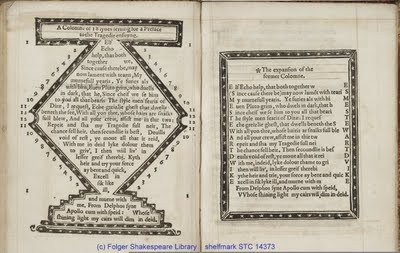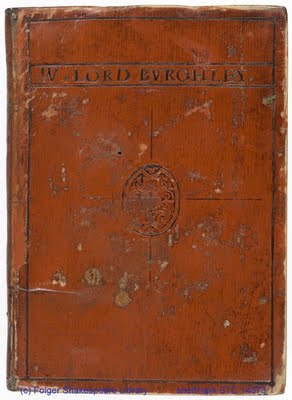
Another example of a student project today, this time at the intersection of politics and poetry as well as of England and Scotland: King James’s The Essayes of a prentise, in the divine art of poesie. This book is a collection of poems and translations by James, as well as “A treatise on the airt of Scottis Poesie.” Published in 1584 in Edinburgh, James was then King James VI of Scotland, and net yet King James I of England, a title he didn’t take until 1603, although the book is cataloged by the STC as authored by James I. (The STC record is the source of the Folger’s catalogue entry for the book; there are standardized rules for all cataloging, of course, but it seems to me misleading to think of this work as being by the King of England, rather than an aspirant to that title.)
There are some great things about this book, including the fact that it’s written in a Scots dialect. Are you surprised that James would write a treatise on poetry? He addresses that very surprise in his preface:
“ze may marvell paraventure, quhairfore I sould have writtin in that mater, sen sa mony learnit men, baith of auld and of late hes already written thairof in dyvers and sindry languages: I answer, That nochtwithstanding, I have lykewayis writtin of it, for twa caussis.”
If you want to know the two causes, you’ll have to read the essay yourself. (By the way, I’ve regularized the u/v usage, as I typically do in transcriptions for this blog, and I’ve reproduced the long “s” form as our modern “s”, but you’ll have to provide your own accent to make sense of the rest of it.)
As you might imagine, part of James’s aim is to argue for the particularity of Scottish learning: the rules for English versification are not and should not be the same as those for Scottish. Just as poesie is also politics in the treatise, so it is throughout the book, which proceeds wtihin a network of Protestant politics, from the Huguenot who printed it while in exile in Edinburgh to the substance of the works.
The book itself has a wonderful sense of presence, including lots of white space and even blank pages (a sure sign of luxuriousness, given the cost of paper). The layout of these poems is a lovely example of early shape poetry:

One of the most interesting aspects of the book isn’t what is in it, but what binds it:

That’s a beautiful, and unusual, orange vellum binding, with tooling, including the name of its owner, W. Lord Burghley. According to research done for a Folger exhibition, this binding is nearly exact that of another copy of this book, one which is tooled with the name “W. Lord Hunsden”. The existence of the two bindings, plus the face that this binding does not resemble the bindings of other books Burghley owned, suggests that it could be a presentation copy by James VI to Burghley–bringing us back to the intersection of poesie and politics.
It was the binding that brought my student to this book–Michael came across it by browsing through Hamnet for “tooling” and “ties”. But, as we’ve seen before, when you start looking at a book from one point of view, others open up, so that he moved from physical object, to text, to social and networks–none of which, of course, are separate from each other.
>I can understand why the author is called "James I, King of England, 1566-1625" in the "Author" field of the online catalog, since you'd want to be able to click the link and find everything written by that person no matter what name they were using at the time (though it would be better if he could be called James VI here and James I elsewhere, and still have all the records come up, that's expensive computer programing and data updating — beyond what libraries can afford). BUT (getting on soapbox) there's no reason the first sentence of the note shouldn't be changed from "By James I, whose name (Jacobus Sextus) is given in an acrostic on A1r" to "By James VI of Scotland, later James I of England, whose name (Jacobus Sextus) is given in an acrostic on A1r." The current wording is misleading (one might go so far as to say "wrong") and I'm willing to bet the cataloging department at the Folger would make the change if you pointed it out.
>The cataloging department is much obliged for the notice. The note now reads: By James VI of Scotland and (later) James I of England, whose name (Jacobus Sextus) is given in an acrostic on A1r.
>I find the intersections between art and politics fascinating – and how this perspective shows a book is much more than 'just' a book.